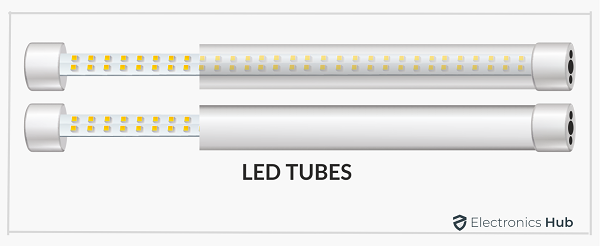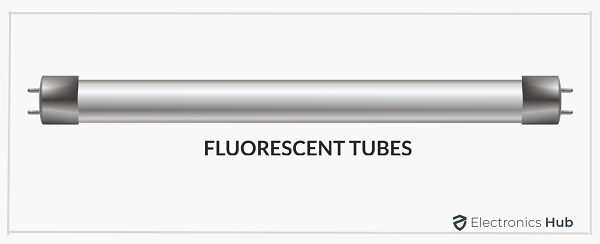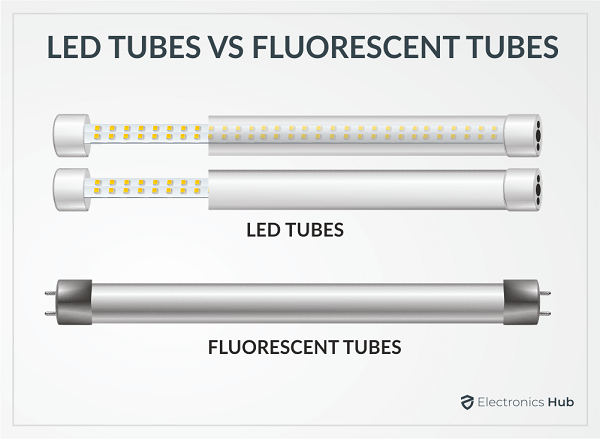In case you’re looking for practical lighting options for larger spaces, then going with a tube light can be a great idea. This is due to the reason that tube lights offer much more light output when compared to a bulb. However, similar to bulbs, tube lights are also available in different types. And two of the common types of tube lights that you can find out there include LED tubes and fluorescent tubes.
As you would expect, both of these types of tube lights have a lot of differences between them. Since this makes it quite difficult to pick one of these, we are here to help!. In this detailed guide, you can learn everything about LED tubes vs fluorescent tubes. Most importantly, you can go through this guide till the find to find a detailed comparison chart for differences between LED tubes and fluorescent tubes.
Outline
ToggleWhat are LED Tubes?
 Before taking a deeper look at the differences between LED tubes vs fluorescent tubes, let’s learn about LED tubes first. As you can probably tell by the name, LED tubes are lighting tubes that use LEDs or Light Emitting Diodes inside them.
Before taking a deeper look at the differences between LED tubes vs fluorescent tubes, let’s learn about LED tubes first. As you can probably tell by the name, LED tubes are lighting tubes that use LEDs or Light Emitting Diodes inside them.
These LEDs are made up of two electrodes which are known as anode and cathode. Usually, these diodes are made out of semi-conductive materials like selenium or silicone. And when an electric current is passed through these diodes, light is produced. This principle is then used on a larger scale in an LED tube light.
What are Fluorescent Tubes?
 Apart from the basics of LED tubes, you should also learn a bit about fluorescent tubes. Fluorescent tubes or compact fluorescent tubes, short for CFL, are another popular type of tube that you can find on the market.
Apart from the basics of LED tubes, you should also learn a bit about fluorescent tubes. Fluorescent tubes or compact fluorescent tubes, short for CFL, are another popular type of tube that you can find on the market.
These tubes are made of glass along with a fluorescent coating on the inside. As for its working, UV radiation is generated using electricity being provided to the tube. This electricity is sent as a discharge inside the inert mercury glass which then produces light.
Functional Differences Between LED Tubes and Fluorescent Tubes
 While we have covered the basics of LED tubes and fluorescence tubes which should be enough for most, some of them might want to learn about their functioning in depth. In that case, you can go through the following:
While we have covered the basics of LED tubes and fluorescence tubes which should be enough for most, some of them might want to learn about their functioning in depth. In that case, you can go through the following:
LED Tubes and Their Functioning
When compared to a fluorescent tube, the functioning of an LED tube is much simpler and fairly similar to any other LED-based lighting fixture. However, unlike other LED lighting solutions, LED tubes have a large number of LED bulbs installed inside a tubular structure which allows for even light distribution and diffusion. And when all the LED bulbs of your LED tube are turned on, the whole tube turns on and starts to emit light
As for the functioning of each LED diode present in your LED tube, these use semiconductor diodes. Whenever electricity passes through these semiconductor diodes, light is emitted. Inside an LED tube, a large number of these LED bulbs are soldered in a line. Apart from being connected to each other, these LED bulbs are also connected to a power supply so that each LED bulb can get enough power to offer even lighting output.
Fluorescent Tubes and Their Functioning
Coming to the functioning of fluorescent tubes, they are much different from LED tubes. Instead of using semiconductors, fluorescent tubes contain a noble gas inside them. While older fluorescent tubes used neon for the same, modern ones rely on argon and krypton.
For generating light using these noble gasses, the noble gas inside a given fluorescent tube is ignited using a high voltage which is generally done using a choke. Due to the high voltage surge, the gas inside the fluorescent gets ionized. This ionized gas then makes the fluorescent material glow which is present on the wall of the glass tube.
LED Tubes vs Fluorescent Tubes
After learning more about the basic functioning and primary characteristics of LED tubes and fluorescent tubes, you may want to pick one for your home or office. But for the same, there is quite a lot more to consider. Thus, make sure to consider the following pros and cons between LED tubes vs fluorescent tubes:
Pros and Cons of LED Tubes
Starting with LED tubes, here are some of the primary pros and cons of LED tubes:
Pros of LED Tubes
There is a reason that most people prefer to go with LED tubes these days since they offer a wide range of advantages including the following:
1. Excellent Efficiency
Since LED bulbs themselves are quite efficient, LED tubes offer excellent efficiency ranging from 90 to 150 lumens per watt.
2. Great Color Rendering
Color rendering of LED tubes, which is given as CRI, can range from 80 to 95 CRI which results in natural-looking colors in your home and office.
3. Adjustable Brightness Options
Because LED bulbs are fully adjustable, LED tubes also allow you to adjust the brightness if you are using a suitable dimmer.
4. Much Longer Lifespan
You can expect your LED tube to easily last for 30000-50000 hours which makes it perfect for long-term usage.
5. Lacks any Turn-On Delay
As soon as you turn on your LED tube, it will fully turn on at maximum brightness right away without having any flicker or needing to heat up.
6. Only Directional Radiation
All of the light produced by LED tubes is radiated or emitted towards a single direction with a beam angle of around 160 degrees or similar which ensures that all light is going towards the room and not the wall.
7. Lacks any Flickering
Since LED tubes use DC voltage and are controlled by a high-frequency LED driver, there is no flickering with LED tubes.
8. Lacks any Mercury
Because LED bulbs only use semiconductors, there is no use of toxic mercury inside LED tubes.
9. Sturdy Construction
Instead of using glass for their construction, LED tubes use plastics like polycarbonate which is impact resistant and results in a highly sturdy construction.
Cons of LED Tubes
Even though LED tubes are highly versatile, even they are not perfect since they do have the following disadvantages:
1. Comparatively More Expensive
As LED tubes have a lot to offer, all of their benefits do come at a price. When compared to other lighting options out there, LED tubes can definitely be a little premium and expensive especially if you’re installing multiple lights at once.
Pros and Cons of Fluorescent Tubes
Now that you know pretty much all the important details about LED tubes, make sure to check out the primary pros and cons of fluorescent tubes as well:
Pros of Fluorescent Tubes
Despite being an older type of lighting solution, there are still many who will pick a fluorescent tube over LED tubes because of these advantages:
1. Good Efficiency
While it may not be the best out there, fluorescent tubes offer good efficiency ratings of around 45 to 100 lumens per watt.
2. Decent Color Rendering
For the average user, the colors produced by a fluorescent tube will look decent enough since you get a CRI rating of 75 to 85 with most fluorescent tubes.
3. Adjustable Brightness via an Electronic Ballast
Depending on the ballast that you are using with your fluorescent tubes, they can also be dimmed to achieve the brightness that you want.
4. Much Cheaper Cost
If you’re on a budget, then you will be glad to know that fluorescent tubes are quite affordable and budget-friendly.
5. Fairly Long Lifespan
Considering the given price and everything, fluorescent tubes offer a fairly long lifespan of around 5000 to 20000 hours. Although, this does depend on the type of electric ballast that you are using.
Cons of Fluorescent Tubes
While fluorescent tubes do offer some benefits, they are far from perfect since you have to deal with various disadvantages like these:
1. Flicker when Powered On
Because fluorescent tubes depend on an electrical ballast for being switched on, they do flicker when turned on along with a delay of a second or so.
2. 360-Degree Radiation Emission
Unfortunately, the light produced by fluorescent tubes gets emitted in all directions which means that some of the light being produced hits the wall instead of being emitted in the room.
3. 120 Hz Flicker Frequency
If you’re using a standard ballast with your fluorescent tube, it will make your tube flicker at 120 Hz which can cause fatigue and headaches for some people due to the strobe effect being produced by this flicker.
4. Presence of Toxic Mercury
Apart from being highly dangerous to accidentally break into your home, the presence of toxic mercury inside your fluorescent tubes also means that it is a hazardous waste in terms of disposal.
5. Fragile Construction
As you know, fluorescent tubes are made out of very thin glass which makes such lights highly fragile especially due to the given length.
Differences Between LED Tubes and Fluorescent Tubes
Even though we have already covered all the major pros and cons as well as differences between LED tubes and fluorescent tubes, you might still be confused. In that case, you can simply go through this quick comparison chart for differences between LED tubes and fluorescent tubes:
| LED Tube | Fluorescent Tube | |
| Materials | Uses plastic, aluminum, and electronics for construction | Uses glass, mercury, and metals for construction |
| Longevity | Usually lasts for 10 years or so | Usually lasts for 5 years or so |
| Recyclability | Aluminum and plastics can be easily recycled | Needs safe disposal due to its mercury contents |
| Efficiency | Offers a much higher efficiency in terms of brightness per watt | Offers a decent efficiency in terms of brightness per watt |
| Installation | Can be installed directly without needing a ballast | Requires a ballast to be installed along with the tube |
| Color Rendering | Outputs lights full of color that looks similar to sunlight | Outputs light with limited colors which makes it look artificial |
Conclusion
Choosing the right lighting fixtures for your home or office can be quite difficult if you’re not familiar with the options available out there. But if you are looking for something made for larger spaces, then you can’t go wrong with either LED tubes or fluorescent tubes. Although, in order to pick one between these two, this guide should have helped you well. We have discussed the basic functioning as well as the detailed pros and cons of LED tubes and fluorescent tubes up above. With this, you should be able to easily choose the ideal lighting solution for your needs. In case you found this guide helpful, make sure to leave all your thoughts and questions in the comments section down below.

